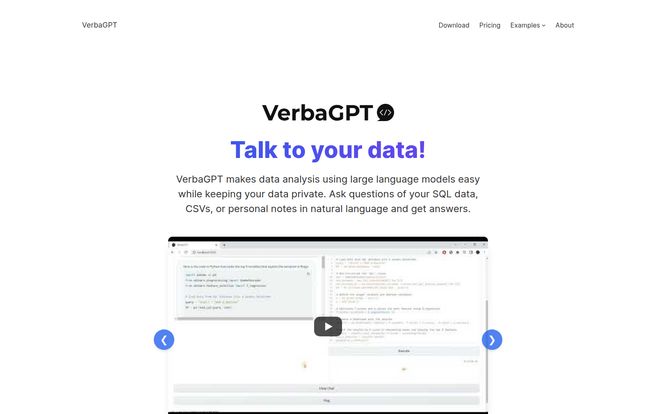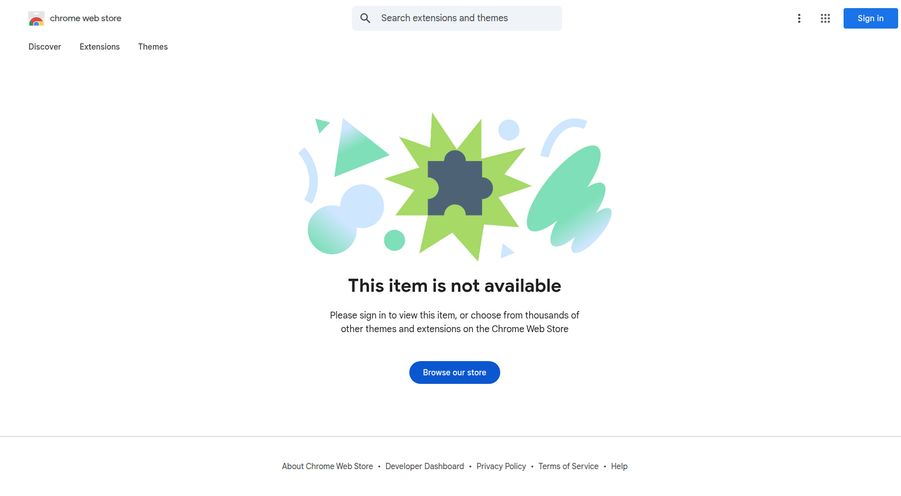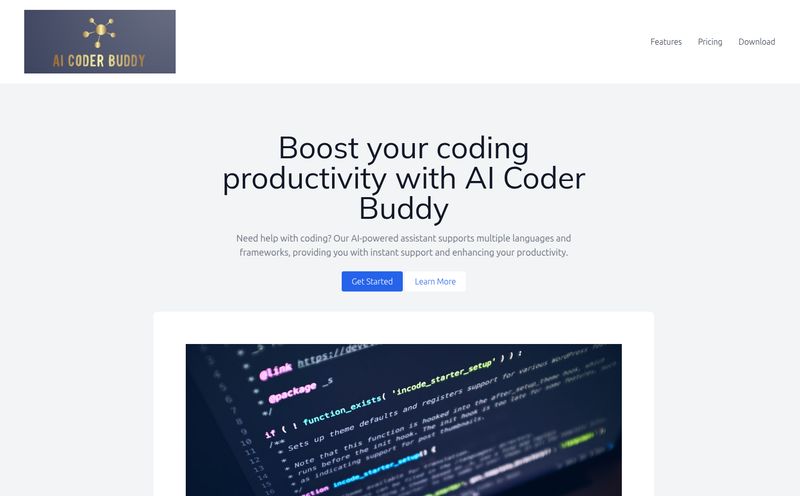We've all been there. Staring at a massive CSV file or a database with a dozen tables, knowing the golden nuggets of insight are buried inside. But the thought of wrestling with SQL joins or firing up a Jupyter notebook just to answer one simple question makes you want to close the laptop and go for a walk. I've spent more hours than I'd like to admit writing queries that felt like casting an arcane spell, only to have them fail because of a misplaced comma.
For years, the promise has been dangled in front of us: "What if you could just ask your data questions in plain English?" We've seen attempts, some clumsy, some okay-ish. But then Large Language Models (LLMs) got... well, good. And now, a new wave of tools is hitting the market. One that caught my eye recently is VerbaGPT. Its tagline is simple: "Talk to your data."
But the real hook, the thing that made me sit up and pay attention, wasn't just the conversational part. It was the privacy. In an age where we're practically handing over our company's crown jewels to every cloud service under the sun, VerbaGPT takes a hard left turn.
So, What's the Big Idea Behind VerbaGPT?
At its core, VerbaGPT is a desktop application that acts as a translator between you and your data. You type a question like, "Show me the top 5 selling products last month in the northeast region," and it generates the code (usually Python) to get that answer from your data source. It works with a decent range of common formats: SQL databases (like MySQL and PostgreSQL), CSV files, and even plain old TXT files.
Think of it less like a rigid BI dashboard and more like having a junior data analyst on your shoulder, ready to write scripts on command. You ask, it codes, you get the result. Simple as that. It’s designed to lower the barrier to entry, to take the tedious coding part out of the data discovery process.

Visit VerbaGPT
The Feature That Truly Matters: Your Data Stays YOURS
This is the part that I think is a genuine game-changer. Most AI tools that do this kind of thing are cloud-based. You upload your CSV, or you give the service credentials to your database. And... poof. Your data is on someone else's server. For a lot of us, especially those in finance, healthcare, or just handling sensitive customer information, that's a non-starter. A complete deal-breaker.
VerbaGPT runs locally on your machine. When it needs the LLM's help to write code, it doesn't send your actual data. It only sends the data's structure—the schema, the column names, etc. The LLM sees the blueprint, not the contents of the house.
This is a massive distinction. It means you can point it at your most sensitive datasets without breaking a sweat or getting a panicked call from your compliance department. The analysis happens on your computer. The data never leaves your control. It even has an experimental offline mode. In a world of data leaks and privacy concerns, this local-first approach isn't just a feature; it's a philosophy. And I'm here for it.
Going Beyond Simple Queries with Text-to-Python
Initially, I thought this might just be another Text-to-SQL generator. Useful, but limited. I was pleasantly surprised to find out its secret sauce is actually Text-to-Python. Why is this better? Because Python, with libraries like Pandas and Matplotlib, can do so much more than just fetch data.
You can ask it to perform complex calculations, do statistical modeling, and even create visualizations. So you can go from "How many users signed up in May?" to "Can you plot a bar chart of monthly user signups for the last year?" without changing tools. This moves it from a simple Q&A device to a more powerful, interactive analysis workbench.
A Few Neat Bells and Whistles
Digging in, I found some thoughtful features that show this was built by people who have actually done data work. There's a Retry button for when the AI inevitably messes up the code—because let's be honest, it will. There's also an Analyze button that gives you a plain-English commentary on the generated code and the results, which is fantastic for learning or for double-checking the AI's logic. You can even toggle between different LLMs (like models from OpenAI or OpenRouter) and train the system by flagging good and bad generations. It's not a black box, which I appreciate.
How Much Does VerbaGPT Cost?
Ah, the all-important question. The pricing page is refreshingly straightforward. I've seen some enterprise tools where finding the price is like an Indiana Jones expedition. Here, it's pretty clear.
| Plan | Cost | Key Details |
|---|---|---|
| Trial | Free | A full-featured 60-day trial for evaluation. This is the one to start with. |
| Personal | Free | After the trial ends, it converts to this. It's for personal use only and limited to small datasets. Still, pretty generous. |
| Commercial | Contact Us | The standard enterprise model. No limitations, priority support, and you're legally cleared for business use. |
The fact that there's a permanently free tier for personal use is a big win for students, indie hackers, and data hobbyists. For businesses, the "Contact Us" model is typical. It probably means the price depends on team size and specific needs.
Let's Talk About the Rough Edges
Alright, it's not all sunshine and rainbows. The creators are upfront that VerbaGPT is experimental software. This isn't a decade-old, battle-hardened platform like Tableau. You're on the cutting edge here, and the edge can sometimes be a bit... buggy. You should expect some errors and quirks.
Also, its greatest strength—the LLM—is also a potential weakness. LLMs can be wrong. They can misunderstand your question and generate code that produces a plausible-looking but incorrect result. My advice? Always treat the output with a healthy dose of skepticism. Use the `Analyze` button and, if you can, glance at the generated Python code to make sure it's actually doing what you think it is. Don't just blindly trust the number it spits out.
So, Who Is This For?
In my opinion, VerbaGPT hits a sweet spot for a few specific groups:
- The Data-Curious Professional: The marketer, the product manager, the startup founder who has data and questions but not the time or desire to become a Python programmer.
- The Security-Conscious Analyst: Anyone working in a regulated industry or with proprietary data who can't risk using cloud-based AI tools. This is their get-out-of-jail-free card.
- Freelancers and Consultants: People who need to quickly jump into a client's dataset, pull some insights, and generate a few charts without a massive software setup.
Is it going to replace a full-scale enterprise BI team with a mature data warehouse and established dashboards? Probably not today. But for ad-hoc analysis and empowering non-coders to find their own answers safely? It's one of the most interesting tools I've seen in a while.
Final Thoughts on VerbaGPT
VerbaGPT is a bold step in the right direction. It combines the power of modern LLMs with a deep respect for data privacy that feels almost rebellious in today's tech climate. It’s not perfect, and you need to go in with your eyes open, aware that it's an experimental tool. But it successfully lowers the barrier between a question and an answer, all while keeping your data securely on your own machine.
It’s a sign of where data analytics is heading: a more conversational, accessible, and hopefully, more private future. I'm excited to see how it develops.
Frequently Asked Questions
- How does VerbaGPT actually protect my data's privacy?
- It runs locally on your computer. When generating code, it only sends the data's structure (schema), not the raw data itself, to the LLM. This means your sensitive information never leaves your machine.
- What kinds of data can I use with VerbaGPT?
- It currently supports connecting to SQL databases like MySQL and PostgreSQL, as well as analyzing individual CSV and TXT files.
- Is VerbaGPT really free to use?
- Yes, it has a free Personal plan that you can use indefinitely for small datasets and personal projects. For business use or larger datasets, you'll need the 60-day free trial or a Commercial license.
- Do I need to know how to code to use VerbaGPT?
- Nope! That's the main appeal. You ask questions in natural language, and it generates the necessary Python code for you. Of course, knowing some code helps you verify the results.
- Can VerbaGPT create charts and graphs?
- Yes. Because it generates Python code, you can ask it to create visualizations like bar charts, line graphs, etc., and it will use popular libraries to generate them.
- What LLMs does VerbaGPT support?
- The platform allows you to toggle between different Large Language Models, including those from providers like OpenAI and OpenRouter, giving you flexibility.



